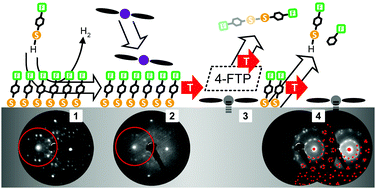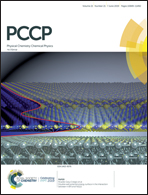Spatial decoupling of macrocyclic metal–organic complexes from a metal support: a 4-fluorothiophenol self-assembled monolayer as a thermally removable spacer†
Abstract
The precise control over the electronic properties and function of metal centres in metal–organic complexes such as metallo-porphyrins (MPs) and metallo-phthalocyanines (MPcs) holds promise for their targeted application in, e.g., nanoscale chemical conversion devices and molecular sensors. However, when immobilizing these flat chelate complexes on solid supports, the influence of the latter on the metal centres can decisively alter their chemistry and functional properties, e.g. through charge transfer and orbital hybridization on metal substrates. In the present work we explore a simple strategy to both spatially and electronically decouple prototypical MP and MPc compounds from a Ag(111) surface, by preventing direct physical contact with the underlying support via insertion of a self-assembled monolayer (SAM) of 4-fluorothiophenol (4-FTP). This spacer layer can be important to preserve the molecular properties of adsorbed MPs and MPcs and to design hybrid functional systems of increasing sophistication such as stacked multilayer architectures. Herein, we show that at low temperature (∼150 K) the 4-FTP SAM on Ag(111) can indeed serve to decouple iron-phthalocyanine (FePc) and ruthenium-tetraphenylporphyrin (Ru(CO)TPP) monolayers from the Ag(111) surface. When the temperature is increased, however, the system's configuration breaks down, resulting in an inverted stacking followed by the complete removal of 4-FTP at elevated temperatures. The SAM can thus play the role of a thermally removable spacer. We elucidate the structural and chemical evolution of the organic double-layer system by combination of X-ray photoelectron spectroscopy (XPS), temperature-programmed XPS (TP-XPS), temperature-programmed desorption (TPD), and low-energy electron diffraction (LEED) measurements.



 Please wait while we load your content...
Please wait while we load your content...